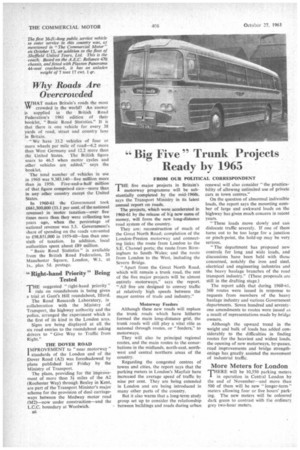Big Five" Trunk Projects Ready by 1965
Page 40

If you've noticed an error in this article please click here to report it so we can fix it.
FROM OUR POLITICAL CORRESPONDENT
THE five major projects in Britain's motorway programme will be substantially completed by the mid-1960s, says the Transport Ministry in its latest annual report on roads.
The projects, which were accelerated in 1960-61 by the release of b:g new sums of money, will form the new long-distance road system of the country.
They are: reconstruction of much of the Great North Road; completion of the London-Preston motorway and connecting links; the route from London to the S.E. Channel ports; the route from Birmingham to South Wales; and the route from London to the West, including the Severn Bridge.
"Apart from the Great North Road, which will remain a trunk road, the rest of the five major projects will be almost entirely motorways," says the report. "All five are designed to convey traffic at relatively high speeds between the major centres of trade and industry."
Motorway Feeders Although these new roads will replace the trunk roads which have hitherto formed the main long-distance grid, the trunk roads will still play a vital role as national through routes, or "feeders," to motorways.
They will also be principal regional routes, and the main routes to the conurbations in the midlands, north-east, northwest and central northern areas of the country.
Regarding the congested centres of towns and cities, the report says that the parking meters in London's Mayfair have increased the average speed of traffic by nine per cent. They are being extended in London and are being introduced in many other parts of the country.
But it also warns that a long-term study group set up to consider the relationship between buildings and roads during urban renewal will also consider "the practicability of allowing unlimited use of private cars m town centres."
On the question of abnormal indivisible loads, the report says the mounting number of large and awkward loads on the highway has given much concern in recent years.
"These loads move slowly and can dislocate traffic severely. if one of them turns out to be too large for a junction or pinch-point, the hold-up may be very serious.
" The department has proposed new controls for long and wide loads, and discussions have been held with those concerned, notably the iron and steel, electrical and engineering industries and the heavy haulage branches of the road transport industry." (These proposals are still in the drafting stage.) The report adds that during 1960-C,I, 360 routes were issued in response to requests from members of the heavy haulage industry and various Government departments. Seven hundred and seventyone amendments to routes were issued as a result of representations made by bridge owncrs.
Although the upward trend in the weight and bulk of loads has added considerably to the difficulties in finding routes for the heaviest and widest loads, the opening of new motorways, by-passes. road improvements and bridge strengthenings has greatly assisted the movement of industrial traffic.
More Meters for London
THERE will be 10,550 parking meters in operation in Central London by the end of November—and more than 500 of them will be new " longer-term " meters allowing four or five hours' parking. The new meters will be coloured dark green to contrast with the ordinary grey two-hour meters.




















































































































